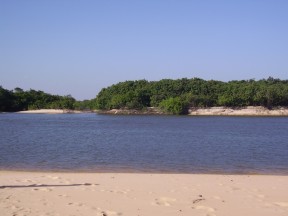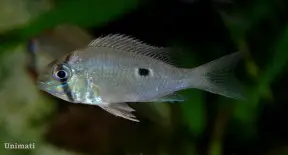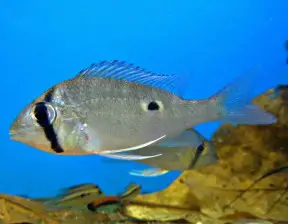Biotodoma wavrini
Orinoco Eartheater
SynonymsTop ↑
Geophagus wavrini Gosse, 1963
Etymology
Biotodoma: from the Greek ‘βίοτος’, meaning ‘living’, and ‘δῶμα’, meaning ‘house’, in allusion to the adults carrying fry in their gills. This behaviour is not applicable to those species currently in the genus, however.
wavrini: named in honour of Belgian ethodocumentarist Marquis Robert de Wavrin, who travelled in South America between 1913-1930, recording the cultures and traditions of indigenous tribes on camera.
Classification
Order: Perciformes Family: Cichlidae
Distribution
Currently known from the middle and upper rio Negro basins in Brazil and Colombia, the Casiquiare system in Brazil and Venezuela, and the Orinoco watershed in Venezuela and Colombia.
Type locality is ‘upper Río Orinoco in Venezuela between San Fernando de Atabapo and Río Casiquiare, Venezuela’, which appears to correspond to the lower Río Ventauri, a tributary of the Orinoco.
Habitat
A natural habitat of this species is the Río Cinaruco, a low nutrient, blackwater tributary of the Orinoco in southwestern Venezuela which comprises a meandering river channel with numerous interconnected lagoons and floodplain lakes.
The latter two biotope-types feature reduced water flow, increased turbidity and temperature, a greater accumulation of leaf litter, and higher densities of zooplankton than the main channel.
Other fishes occurring in the Río Orinoco basin and available in the trade include Corydoras delphax, Platydoras costatus, Baryancistrus beggini, Hypancistrus inspector, Panqolus maccus, Panaque nigrolineatus, Hemigrammus rhodostomus, H. stictus, Hyphessobrycon sweglesi, Paracheirodon axelrodi, Pristella maxillaris, Copella nattereri, Heros severus, Mesonauta insignis, Satanoperca daemon and Uaru fernandezyepezi.
Maximum Standard Length
90 – 100 mm.
Aquarium SizeTop ↑
Base dimensions of 150 ∗ 45 cm or more are recommended.
Maintenance
Ideally a soft, sandy substrate should be used since members of this genus are largely benthophagous. Additional décor is largely a case of personal taste, but the most favoured set-ups tend to feature relatively dim lighting plus some chunks of driftwood and scattered roots or branches. One or two water-worn rocks can also be included to provide potential spawning sites if you wish.
Water quality is of the utmost importance since these cichlids are susceptible to deteriorating water quality and should never be introduced to a biologically immature aquarium. The best way to achieve the desired stability is to filter the tank using a combination of external canister filters and/or a sump system and perform minimum weekly water changes of 50-70%.
If the maintenance regime and/or diet is insufficient individuals may develop health problems such as head and lateral line erosion or exhibit stunted growth.
Mechanical filtration should be tailored to trap small particles stirred up by the fish as sand can cause blockages or wearing issues with filter mechanisms if allowed to continually run through the system.
Water Conditions
Temperature: 20 – 30 °C
pH: 4.0 – 6.5
Hardness: 18 – 90 ppm
Diet
The diet should contain a variety of high quality, fine-grade prepared foods plus live or frozen chironomid larvae (bloodworm), Tubifex, Artemia, mosquito larvae, etc. At least some of the dried products should contain a significant proportion of vegetable matter such as Spirulina or similar.
Home-made, gelatine-bound recipes containing a mixture of dried fish food, puréed shellfish, fresh fruit and vegetables, for example, are proven to work well and can be cut into bite-sized discs using the end of a sharp pipette or small knife.
Rather than a single large meal offer 3-4 smaller portions daily to allow natural browsing behaviour as this seems to result in the best growth rate and condition.
Behaviour and CompatibilityTop ↑
Unless breeding this species is surprisingly peaceful and will not predate on fishes larger than a few mm in length. Suitable tankmates are therefore too numerous to list but include most peaceful species enjoying similar environmental conditions.
Best avoided are territorial or otherwise aggressive fishes or those requiring harder water, however.
Biotodoma species are loosely gregarious and tends to live in groups unless spawning with juveniles in particular displaying a strong social response when threatened. A group of 5-8 individuals should therefore be the minimum purchase and these will form a noticeable dominance hierarchy which adds behavioural interest for the observer. When maintained in smaller numbers weaker specimens can become the target of excessive abuse by dominant individuals or the group may fail to settle and behave nervously.
Sexual Dimorphism
Unconfirmed, though males supposedly grow larger than females and may develop slightly more-extended fins.
Reproduction
Information is very scarce and the species may never have been bred in aquaria. The congener B. cupido is a biparental substrate spawner and presumably this species adopts a comparable strategy.
NotesTop ↑
Populations known in the aquarium trade include ‘Cuao’, ‘Orinoco’, ‘San Antonio’, and ‘Sipapo Ventuari’.
B. wavrini and its congener B. cupido can be separated by body shape and position of the dark blotch on the posterior portion of the flank. In B. cupido the body is relatively compact and the blotch located above the upper lateral line, whereas in B. wavrini the body is noticeably elongate and the blotch on or below the upper lateral line.
Kullander (1998) conducted a morphology-based phylogenetic study in which the neotropical family Cichlidae was divided into six subfamilies of which the putative subfamily Geophaginae contained 16 genera divided among three ‘tribes’:
Acarichthyini – Acarichthys and Guianacara.
Crenicaratini – Biotoecus, Crenicara, Dicrossus and Mazarunia.
Geophagini – Geophagus, Mikrogeophagus, ‘Geophagus‘ brasiliensis group, ‘Geophagus‘ steindachneri group, Gymnogeophagus, Satanoperca, Biotodoma, Apistogramma, Apistogrammoides and Taeniacara.
Later molecular studies by Farias et al. (1999, 2000, 2001) resulted in the additions of Crenicichla and Teleocichla to the Geophaginae, a result supported by López-Fernández et al. (2005) who conducted the most detailed molecular analysis of the grouping to date including 16 of the 18 genera and 30 species.
However their conclusions regarding interrelationships between genera did vary somewhat from previous hypotheses and can be summarised by the following loosely-defined groups:
– a weakly-supported sister group relationship between Acarichthys and Guianacara.
– a well-supported “Satanoperca clade” comprising Satanoperca, Apistogramma, Apistogrammoides and Taeniacara.
– a “big clade” with Geophagus, Mikrogeophagus, ‘Geophagus‘ brasiliensis group, ‘Geophagus‘ steindachneri group, Gymnogeophagus, Biotodoma, Crenicara and Dicrossus.
– a “crenicarine clade” with Biotoecus and Crenicichla.
No representatives of Teleocichla or Mazarunia were included in the study but the former is well-established as sister to Crenicichla while the latter has grouped closely with Dicrossus and Crenicara in earlier works.
The other main conclusions of the paper are confirmation that Geophaginae is a monophyletic group exhibiting strong signs of having undergone rapid adaptive radiation.
References
- Gosse, J.-P., 1963 - Bulletin de l'Institut Royal des Sciences Naturelles de Belgique 39(35): 1-7
Description de deux cichlidés nouveaux de la région amazonienne. - Cichocki, F. P. , 1977 - Environmental Biology of Fishes 1(2): 159-169
Tidal cycling and parental behavior of the cichlid fish Biotodoma cupido. - Kullander, S. O., 1986 - Department of Vertebrate Zoology, Research Division, Swedish Museum of Natural History, Stockholm, Sweden, 394 p.: 1-431
Cichlid fishes of the Amazon River drainage of Peru. - López-Fernández, H., R. L. Honeycutt and K. O. Winemiller, 2005 - Molecular Phylogenetics and Evolution 34(1): 227–244
Molecular phylogeny and evidence for an adaptive radiation of geophagine cichlids from South America (Perciformes: Labroidei). - Reis, R. E., S. O. Kullander and C. J. Ferraris, Jr. (eds), 2003 - EDIPUCRS, Porto Alegre: i-xi + 1-729
Check list of the freshwater fishes of South and Central America. CLOFFSCA.








